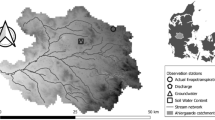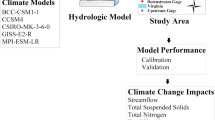Abstract
We demonstrate the use of a quantitative measure of the effectiveness of using climate model simulations of surface precipitation and temperature for water resources applications involving extremes of watershed average precipitation and temperature, and watershed discharge. This diagnostic measure is considered in association with the use of climate information to condition ensemble seasonal predictions of watershed variables. Seven watersheds in the Korean peninsula constitute the application sites. The climate model effectiveness is expressed by a utility index EP that measures the ability of the climate model simulations of an indicator variable (i.e., nodal precipitation or temperature) to discriminate observed distributions of the highs and lows of a watershed target variable (i.e., mean areal precipitation and temperature as well as outlet discharge). Monte Carlo simulations provide estimates of the significance of the Ep values. For apparently the first time, ten-member ensemble simulations of daily surface precipitation and temperature from the Korean Meteorological Agency climate model are used to evaluate the climate-model utility index EP for a temporal interval of 10 days for each application watershed. The results show that, in spite of the high uncertainty of climate simulations, there are several Korean watersheds that can benefit from the use of climate model simulations of high temporal resolution for planning and management studies that involve precipitation, temperature and discharge. In particular, seasonal ensemble prediction of watershed variables stands to gain from conditioning on high-temporal resolution climate forecasts.
Similar content being viewed by others
References
Back, S.-K., Ryu, J.-H., and Ryoo, S.-B., 2002, ‘Analysis of the CO2 doubling experiment using METRI AGCM, PART 1: The Characteristics of Regional and Seasonal Climate Responses’, J. Korean Meteor. Soc. 38(5), 465–477 (in Korean).
Carpenter, T. M. and Georgakakos, K. P. 2001, ‘Assessment of Folsom Lake response to historical and potential future climate scenarios, 1, Forecasting’, J. Hydrol. 249, 148–175.
Chen, S.-C., 2002, ‘Model mismatch between global and regional simulations’, Geophys. Res. Lett. 29(5), 4-1–4-4; DOI: 10.1029/2001GL013570.
DeGroot, M. H., 1975, Probability and Statistics, Addison-Wesley, Reading, MA, pp. 463–471.
Georgakakos, A. P., Mullusky, M. G., Yao, H., and Georgakakos, K. P., 1998, ‘Impacts of climate variability on the operational forecast and management of the upper Des Moines River basin’, Water Resour. Res. 34(4), 799–821.
Georgakakos, K. P., 2003, ‘Probabilistic climate-model diagnostics for hydrologic and water resources impact studies’, J. Hydrometeorol. 4, 92–105.
Georgakakos, K. P., Graham, N. E., and Georgakakos, A. P., 2000, ‘Can forecasts accrue benefits for reservoir management? The Folsom Lake study’, Climate Rep. 1(4), 7–10.
Georgakakos, K. P., Seo, D.-J., Gupta, H., Schaake, J., and Butts, M. B., 2004, ‘Towards the characterization of streamflow simulation uncertainty through multimodel ensembles’, J. Hydrol. 298, 222–241.
Goddard, L., Mason, S. J., Zebiak, S. E., Ropelewski, C. F., Basher, R., and Cane, M. A. 2001, ‘Current approaches to seasonal-to-interannual climate predictions’, Int. J. Climatol. 21, 1111–1152.
Jeong, C. S., Heo, J.-H., Bae, D.-H., and Georgakakos, K. P., 2005, ‘Utility of high-resolution climate model simulations for water resources prediction over the Korean peninsula: A sensitivity study’, Hydrol. Sci. J. 50(1), 139–154.
Kharin, V. V. and Zwiers, F. W. 2000, ‘Changes in the extremes in an ensemble of transient climate simulations with a coupled atmosphere-ocean GCM’, J. Climate 13, 3760–3788.
Krzysztofowicz, R., 1999, ‘Bayesian theory of probabilistic forecasting via deterministic hydrologic model’, Water Resour. Res. 35, 2739–2750.
Kundzewicz, Z. W. and Somlyódy, L. 1997, ‘Climatic change impact on water resources in a systems perspective’, Water Resour. Manage. 11(6), 407–435.
Livezey, R. E. and Chen, W. Y. 1983, ‘Statistical field significance and its determination by Monte Carlo techniques’, Mon. Weather Rev. 111(1), 46–59.
Meehl, G. A., Karl, T., Easterling, D. R., Changnon, S., Pielke, R. Jr., Changnon, D., Evans, J., Groisman, P. Y., Knutson, T. R., Kunkel, K. E., Mearns, L. O., Parmesan, C., Pulwarty, R., Root, T., Sylves, R. T., Whetton, P., and Zwiers, F., 2000, ‘An introduction to trends in extreme weather and climate events, observations, socioeconomic impacts, terrestrial ecological impacts, and model projections’, Bull. Am. Meteorol. Soc. 81(3), 413–416.
Murphy, J., 1999, ‘An evaluation of statistical and dynamical techniques for downscaling local climate’, J. Climate 12, 2256–2284.
Press, W. H., Teukolsky, S. A., Vetterling, W. T., and Flannery, B. P., 1992, Numerical Recipes in FORTRAN, The Art of Scientific Computing, Cambridge University Press, New York, 963p.
Shukla, J. and others, 2000, ‘Dynamical seasonal prediction’, Bull. Am. Meteorol. Soc. 81, 2593–2606.
Smith, J. A., Day, G. N., and Kane, M. D. 1991, ‘A nonparametric framework for long-range streamflow forecasting'. WMO/TD-428, World Meteorological Organization, Geneva, Switzerland, 28p.
Stephens, M. A., 1970, ‘Use of the Kolmogorov-Smirnov, Cramer-Von Mises and related statistics without extensive tables’, J. R. Stat. Soc., Ser. B 32(1), 115–122.
Stern, P. C. and Easterling, W. E. (eds.), 1999, Making Climate Forecasts Matter, National Academy Press, Washington, DC, 192p.
Wang, X. L. and Zwiers, F. W., 1999, ‘Interannual variability of precipitation in an ensemble of AMIP climate simulations conducted with the CCC GCM2’, J. Climate 12, 1322–1335.
Xu, C., 1999, ‘Climate change and hydrologic models, A review of existing gaps and recent research developments’, Water Resour. Manage. 13(5), 369–382.
Yao, H. and Georgakakos, A. P., 2001, ‘Assessment of Folsom Lake response to historical and potential future climate scenarios, 2, Reservoir management’, J. Hydrol. 249, 176–196.
Author information
Authors and Affiliations
Corresponding author
Rights and permissions
About this article
Cite this article
Georgakakos, K.P., Bae, DH. & Jeong, CS. Utility of Ten-Day Climate Model Ensemble Simulations for Water Resources Applications in Korean Watersheds. Water Resour Manage 19, 849–872 (2005). https://doi.org/10.1007/s11269-005-5605-x
Received:
Accepted:
Issue Date:
DOI: https://doi.org/10.1007/s11269-005-5605-x




